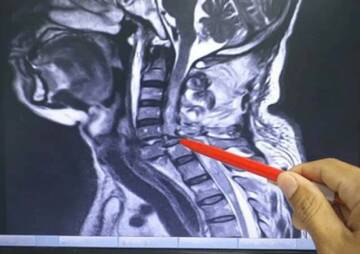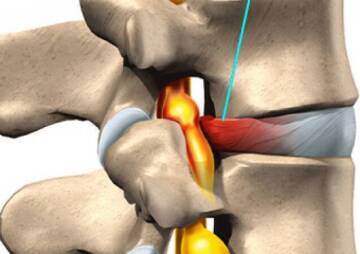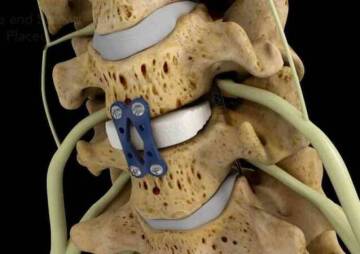-
Category
Craniomaxillofacial Surgery
Orthopedic Surgery
Spine Surgery
Orthopedic Implants
Hip Surgery
Knee Surgery
Pectus Excavatum
Bone Graft
Disinfectants
Healthcare
What are Spinal Injections’ Side Effects?

Thus, back pain is the kind of pain that can put the person to a bed rest if it gets severe and if it is not paid attention to. There are injections for the back pain, apart from surgeries and non-surgical procedures. These injections are used as a treatment option with the epidural spinal steroid injections, which are for the back and neck pain, the sacroiliac injections, and the facet joint injections.
Back, being the center and the most important part of the human body, is very delicate. Thus, back pain is the kind of pain that can put the person to a bed rest if it gets severe and if it is not paid attention to. There are injections for the back pain, apart from surgeries and non-surgical procedures. These injections are used as a treatment option with the epidural spinal steroid injections, which are for the back and neck pain, the sacroiliac injections, and the facet joint injections.
What are Spinal Injections?
Spinal injections can be used in two respective manners. First, they can be used to diagnose the source of the pain in the areas such as the back, leg, and neck. Second, these spinal injections are used as a treatment to relieve the pain and stress of the back. Spinal injections are usually used as a comprehensive treatment program, and these treatments usually include exercise programs to improve and maintain the mobility and the stability of the spine.
Spinal injections are always taken under the guidance of x-ray, which is called fluoroscopy. This process is done to confirm the place of the medication and its safety. Thus, before injecting the medicine, a liquid contrast is injected. If the contrast does not flow in the exact location, the surgeon will reposition the needle, and then additional dye is injected until the flow is obtained correctly.
There are variety of spine injections, each of which have their own respective role and advantage for the patient and for improving the quality of the life of an individual. When the spine injections are combined with physical regime of rehabilitation, then we can expect a long-term solution for the back and neck.
Types of Spinal Injections
The types of injections explained below are used to treat and diagnose certain conditions of damage and injuries, and assist the doctors as well as the patients to get a better handle on the health. The spine injections and the location they are injected vary and each is used to treat a specific kind of pain, but the goal is the same. The types are as follows.
Lumbar Epidural Steroid Injection
The lumbar epidural steroid injection is taken on the lower back, where it is called lumbar region, and is given in the space of epidural in order to reach the canal of the nerve. The process of injecting is guided by an x-ray machine known as fluoroscopy and is used to treat the pain in the lower back and the leg.
Lumber Transforaminal Epidural Steroid Injection
This injection is used to treat pain of the lower back as well as general back pain. This injection can be used to treat the pain of the sciatica, as well. The treatment uses a needle and it takes a few days until the steroids starts working. The result of this injection is far less risky compared to the other invasive options.
Caudal Epidural Steroid Injection
Caudal injection is given right at the bottom of the back near the tailbone. The target of this injection is spinal nerves, where a needle is used to guide an area known as the sacral hiatus, which is above the tailbone. The steroid is injected right at the bottom of the spinal canal.
Thoracic Epidural Steroid Injection
Injection of thoracic epidural steroid is not only used to treat back pain , but it is also used for treating the pain in the flank and abdomen. As stated in other cases, this process will show improvements after a few days. This injection does not target the lower back and the neck only, but more the mid-back pain treatment. The causes of pain in such areas include disk herniation and injury caused to the stenosis of the spine.
Epidural Spinal Steroid Injection
The epidural spinal steroid injection is an efficient procedure for back pain. ESI is a common method for treating the inflammation related to the lower back leg pain, as well as neck-related pain in the arm. In the process of both these cases, the spinal nerves are inflamed due to the narrowing of the passages. The narrowing of such passages is due to several causes, such as bone spur, herniated disk, ligaments becoming thick, and spondylolisthesis.
Some epidural spinal steroid injections are used as a tool to relieve the pain, and some are used just as a diagnostic tool to treat the patients. There are three ways for delivering the steroid in the epidural space, namely, the interlaminar approach, caudal approach, and the transformational approach.
In interlaminar approach, the needle is placed in the back of the epidural space and delivers the steroid in a wider coverage. The caudal approach uses the small boney opening located near the tailbone and is also called as sacral hiatus. Finally, in the transformational approach, which is also known as nerve block, the needle is placed along it and then the medication is placed in the nerve sleeve.
All the three processes are performed on an outpatient fundament. Some patients are unable to take the injection and ask for a mild procedure, while others take a local anesthesia and undergo the procedure.
Epidural Spinal Steroid Injection Side Effects
It must be noted that this procedure has its own risks and side effects, resulting from the steroid medication itself. These side effects are rare compared to the oral steroids. Some of the reported side effects are:
Increase in pain, headache which resolves within 24 hours, anxiety, being sleepless, fever, severe arthritis of the hips, high blood sugar, and ulcers in the stomach.
Selective Nerve Root Block
SNRB, or better known as selective nerve root block injection, is used to diagnose and treat a spinal nerve which is inflamed. The medication anesthetic with steroid is injected right near the nerve of the spine in the intervertebral foremen. The medication helps to numb the pain caused by the nerve.
When the steroids are used to treat the individual, they are missed with anesthetics or are used alone. In order to prevent infections, the skin above the treatment is cleaned properly and then a small amount of dye is injected to check the exact position of the needle and to prevent injecting into the blood vessel. In the case of cervical spine, one injection has resulted in positive results for 75% of the patients, and the outcome was recorded in six months. In the case of lumbar spine, one injection has resulted in only 46% of the patients seeing improvements and the outcome was recorded in one year. It is suggested to start therapies on the advice of the physician once the pain is reduced.
Selective Nerve Root Block Side Effects
Some of the common side effects of the selective nerve root blocks injections are:
- Rashes and itching
- An increase in the weight of the individual
- Extra energy
- Soreness at the area of the injection
- Bleeding
- And, in rare cases, death.
Facet Joint Injection
Facet joint injections are used for diagnostic and therapeutic reasons and are placed around the facet joints. These are small joints located between the vertebrae on the back of the spinal cord. This type of injection is used for the pain caused by the degenerative conditions or injury.
Neck, middle back, and lower back pain are treated with the help of facet joint injection. There are two injection methods available: one is injecting the anesthetic directly in the joints, and second, anesthetizing the nerves that carry pain. In case the pain is relieved with the help of anesthetic injection into the joint, the therapeutic injection is then used to provide long-lasting neck and lower-back pain relief. For patients who are still trying to understand what the reason of their back pain is, the facet joint injection is a good option.
The procedure of the facet joint injection is done without any sedation and while the patient is lying on the stomach, the back area to be tested is cleaned in order to avoid infection. The process of injecting takes only a few minutes, while the entire process takes between twenty to thirty minutes. The physician usually advices the patient to avoid any heavy activities one day before the injection, and in case sedation was used, the patient is advised not to drive for 24 hours after the process.
Facet Joint Injection Side Effects
The following are the side effects of the facet joint injection:
Allergic reaction: There are no life-threatening allergies and they are usually related to the steroid and the x-ray contrast. Very rare cases of anesthetic allergy have been recorded.
Infection: In less than 1% to 3% of the cases, minor infection has occurred. The severe infections are rarely occurring in 0.1% of the facet injections.
Minimal pain is a common side effect. In some cases, the patient’s body of the has shown reactions to the medication such as cortisone. Other side effects that have been recorded are dizziness and muscle soreness.
Sacroiliac Joint Injection
As the name suggests, this injection is an injection of the anesthetic and the steroid injected in the sacroiliac joint of the patient. This particular injection serves many purposes. The sacroiliac injection is done to localize the pain and generate it by reducing the pain in the lower back of the patient. There are risks associated with this particular injection such as infection, increase in the pain, high level of blood sugar, sciatic injury to the nerve, and allergic reaction.
In the case of sciatic, people who are allergic to the anesthesia, patients having bleeding disorders, heart failures or diabetes, and patients who are suffering from tumor should avoid the sacroiliac joint injection. The injection reduces the pain and improves the flexibility of the back. The sacroiliac injection can be done by a team of interprofessional physicians, including a radiologist, an orthopedic surgeon, a sports physician, and a rheumatologist. A sacroiliac injection should be done by a healthcare worker who knows how to manage the complications arising during and after the injection procedures.
Sacroiliac Joint Injection Side Effects
It is commonly asked if the sacroiliac injection has side effects. Is it safe? Is it worth it?
Some common and potential side effects recorded so far are bruising at the sight of the sacroiliac joint injection, allergic reaction which can be caused either by anesthesia or the steroid, infection if the skin was not cleaned before and after the injection, pain increase, reduction of flexibility and elasticity of the surrounding ligaments and soft tissues, and degeneration of the cartilage. Some negative effects can be side effects such as increase in the weight, blood pressure, and the level of blood sugar.
Back Pain Injection
Injection in the back is advised by the doctor when all the treatments have failed to ease the pain and the patient has lost flexibility. Back injections help to solve two main issues: inflammation or a damage caused to the nerve and spinal stenosis.
Inflammation usually occurs in the neck and the back of an individual and doctors call it radiculopathy. In this case, the pain shoots sharply from the lower back to the legs or from the neck to the arms. Another cause of radiculopathy can be a herniated disk.
Spinal stenosis means the spine has narrowed and it is because of the herniated disk pressing against the spinal cord. This pain, which originates from the stenosis, may get worse during activities and it may calm when resting.
To ease the pain, there are few injections, such as epidural, as stated above, nerve block, and discography. The back injections may have side effects like nausea, vomiting, headache, soreness, and pain at the place of the injection. Injections can cause bleeding and infection, though it is rare, but a talk with the doctor will be of some great use.
Risks of Spinal Injections
Risks associated with spinal surgery are:
- Bleeding
- Infection
- Injury to the nerve
- Arachnoiditis
- Paralysis
- Avascular necrosis
- Headache
- Muscle weakness
In this article, all the injections along with their side effects have been introduced. Back pain has many alternatives. Apart from non-surgical process and surgeries, the back pain can be eased through respective injections with the suitable healthcare worker. We hope this content was useful for you.
Resources : spine, pinnaclepainaz






